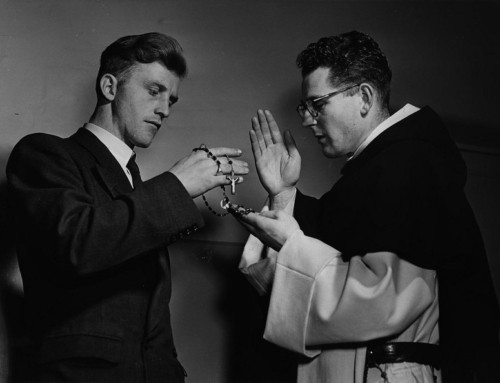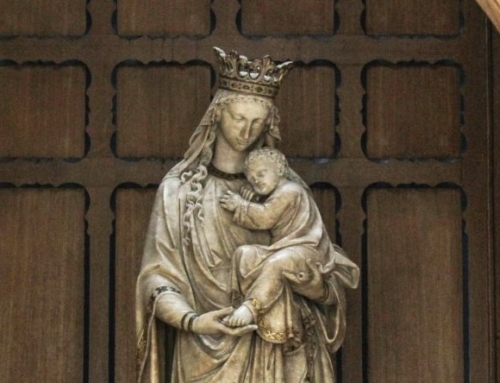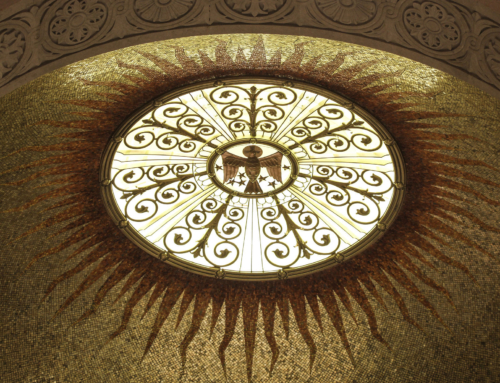Michael O’Brien. The Fool of New York City. San Francisco: Ignatius, 2016.
Editor’s Note: This review discloses significant plot details.
The ability to capture the heart of a reader is a mark of an artist—one who understands the human mind and psyche. Michael O’Brien’s most recent novel, The Fool of New York City, seizes his reader in just this way as he tells the story of a young man seemingly broken by his suffering. The drama of Paul Maximilian Davies—a man in his early twenties who has suffered from amnesia as the result of a yet unknown event—is one that puts us face-to-face with the despair of not knowing oneself. Through the course of the story, as he comes to learn of his identity, Max’s return to himself is essentially paired with his suffering. Max learns that to come to know who he is means that he must face himself, the real Paul Maximilian Davies, no matter the cost.
The story of Max’s struggle plays out in four parts, delineated by occasions of self-discovery. We are first introduced to a young homeless man without a name, confused by the world around him. Waking up in an abandoned house in New York City, he questions his existence: “Are there other hints out there? Will they tell you your name and your purpose? Will they explain why you are here? You are pressing your face to the glass, waiting for the answers to these questions” (10-11). And in response to this quasi-prayer, a giant man named Billy finds Max and rescues him. The rest of the story follows on the development of this relationship and the reciprocal nurturing that they provide for each other.
Billy believes that, in order to determine Max’s true identity, the two of them should follow whatever bits of memory Max has left. The second part of the novel begins when Max believes that he is the painter Francisco de Goya, after having visited the Metropolitan Museum of Art. Max continues to have jumbled memories of his past, which leads the pair to the Canadian border and eventually to Vermont. There, in rural New England, they find the ruins of an old family home and brewery where Billy discovers Max’s wallet and identification.
Learning his real name, we are drawn with Max into his past, to the core of his suffering. After finding his old apartment, Max remembers the tragic events of his life: the death of his parents and younger brother on September 11, 2001, and his separation from the woman he loved, Françoise. After losing Françoise, while in a spiraling depression, Max left New York City to go to his grandparents’ home in Vermont where he fell through the ice on the pond, causing his amnesia.
The final part of the novel details Max’s coming to terms with his past. Though he struggles with re-encountering these painful realities, with the friendship of Billy he slowly heals. Through the pain he is able to live with himself, to come to know himself, and to begin to grow into the man he has always longed to be.
O’Brien’s gift is that he is not only able to elicit sympathy from his readers, but empathy as well. We are drawn to the characters of his novel, not just to read about their pain and joy, but to actually identify, in our own ways, with them. Over the course of the narrative O’Brien pricks those places in our own hearts that we fear, those places that we prefer to leave alone. Yet his story does not leave us here. He beautifully and subtly works redemption into the story with such finesse that it almost goes unnoticed.
During Max’s venture into his past, he remembers a note that his grandfather wrote for him several years after the death of his family. Worrying about his grandson’s future he muses about those who must endure incredible grief and their grasp for comfort: “For some, this takes shape in the mind as dreams of ambition fulfilled, earthly securities seized at all costs and held at all costs. For the best of men, it is a yearning forward to a better self. In most, if not all, there reign the soundless alarums of fear. By love do we cast out fear. By love do we become who we are” (170). The casting off of fear through love is a motif that runs consistently throughout the novel, most especially in the relationship between Billy and Max.
It is only in this relationship with another that Max finds himself. Reminiscent of the words of the Second Vatican Council, “[Christ] fully reveals man to man himself” (Gaudium et Spes, 22), Max realizes this in his despair: “Goodness has no explanation. You cannot trust it. But you have nowhere else to go” (19). Over and again, he steps deeper back into reality along with someone else. O’Brien describes how Max stands “side by side,” either with Billy (249, 251), or Françoise (196), or Katie (268), a girl with whom he falls in love at the end of the novel.
The connection of self-discovery and friendship, though, is not limited to the purely natural. For O’Brien, and for his characters, friendship is something that transcends earthly limits and carries us to Christ. There is a delicate, but robust sense of man’s instrumental participation in the salvation of others. At their first meeting, because Max is suffering from hypothermia, Billy helps him into dry, warm clothes. In this moment, Billy becomes an alter Christus: “The giant again kneels and removes your wet sandals and socks. Your feet are blue. He dries your feet with a towel. He brings socks that he pulls over your feet” (20). Billy’s departure at the end of the novel evokes a sort of ascension—though he is no longer with Max in person, he does not abandon him, leaving signs of his presence in Max’s life.
O’Brien ends the novel on Christmas. While at Church with Katie and her family on Christmas Eve, Max reflects on being with Christ, something new, but not out of place: “As if this, here, was the humble center of the universe, and I had reached it at last. No one, not even a person like me, was excluded. Though I did not yet fully know it, I was home” (277-78). The next morning, outside his door, he finds a stuffed merganser that he and Billy had restored when they first met.
The Fool of New York City does something unique—it captures the powerful and often unspoken reality of the salvific nature of love, not in some abstract way, but through the tangible friendship of Billy and Max. O’Brien draws on something all human beings need: the love of another without which we begin to lose our identity. Friendship with others, and ultimately friendship with Christ, is the principle of humanization; without it we become objects, the playthings of our loneliness. O’Brien takes us on Max’s journey as if it was our own, inviting us to heed the words of Max’s grandfather: “By love do we cast out fear. By love do we become who we are.”
✠
Download a PDF of this review HERE



